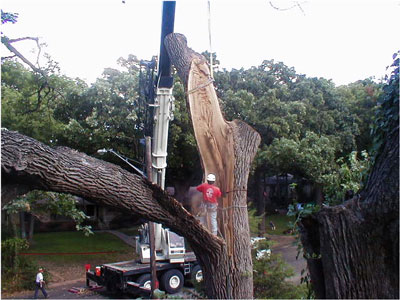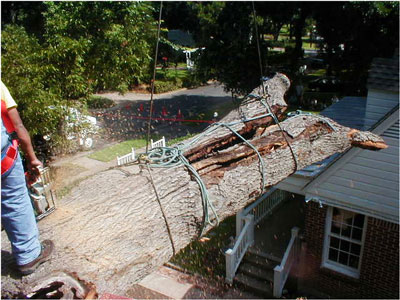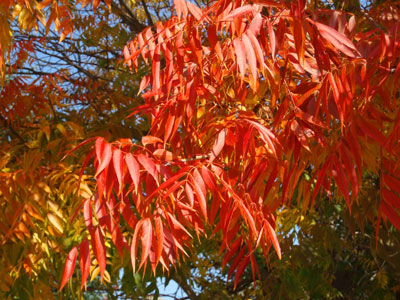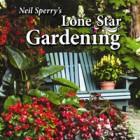Texas Tree Tips: October 2014

Crane removing a large log. Note the limb on the left was lying on the house after high winds caused a split in the tree. Photo by Arborilogical Services.
by Steve Houser
Tree Planting, Part 1 — Site and Species Selection
The right tree planted in the right location provides the maximum amount of value at the lowest possible cost and avoids unexpected problems. The wrong tree planted in the wrong location will always create headaches and often costs more for maintenance. A large-growing shade tree planted too close to a home or building will cost more to keep the tree pruned back from the structure. It also may need to be removed some day at a much higher cost than a tree in an open area. A tree growing near a house with a canopy extending over the roof will require extensive and time-consuming roping to avoid damaging the structure. Large limbs can weigh hundreds or thousands of pounds, which may require a crane to safely remove them. If you plant too close to a structure, it is great job security for your arborist but not always great for your budget.

A split limb over a roof that required a rope tied in several spots to hold it together as it was removed. The two cables around the trunk came from a crane set up in the street to remove the limb safely. Photo by Arborilogical Services.
If you have an open spot that you feel needs a tree, please consider doing the research and thinking required to do it right. You can be “a real hero or a big zero.”
Here is a list of questions to ask:
- What characteristics of a tree do you prefer in the spot? If you need a screen for a view or to block noise, you may need an evergreen tree that retains its leaves in the winter. The leaves of a deciduous tree provide shade in the summer, reducing the cost to cool your home; and in the fall the leaves will drop and allow the sun in, reducing the cost to heat your home. What flowers or fruit would you prefer, and would they be a pleasure or a nightmare in the future? What texture of foliage would be fitting, and would fall color be a preference? Any other needs as far as aesthetics?
- What size of tree will fit in the spot? Consider the mature size of any tree species before you plant. The best way to know is to check the largest tree of its species — often called a “champion” tree. The state champ list is on the Texas Forest Service website. The DFW area champs are list on the Texas Tree Trails website. These sites also provide a great deal of information on tree species characteristics to consider before planting. A large-growing shade tree should be at least 25 to 30 feet from a foundation. It will need a large amount of open space for root growth (not under concrete or non-permeable surface). An ornamental tree can be as close as 10 to 15 feet, depending on the species and its size at maturity.
- Always look for overhead lines when you consider the mature size of a species. Also, be sure to check for any underground lines. These can be marked for free by calling 1-800-DIGTESS
- Consider how much sun is available for a new tree in the area. It is important to try to project the future growth of the surrounding trees to avoid conflicts. That little oak tree in the neighbor’s yard may one day shade everything you plant nearby.
- Check the type of soil on the site and its depth, as well as the preferred soil type for the species of tree. It is tough to plant a tree with solid rock 6 inches under the soil unless you have a spare jackhammer in the garage. Also, some tree species will tolerate sandy or acidic soil only, and others will tolerate only clay or alkaline soil. If you are not sure, check a soil map for your area, or have a soil sample analyzed to be sure that the species of tree you choose will tolerate your soil. If not, you may plant a rainbow tree that turns some gorgeous colors … just before it croaks.
- Research the tree species’ ability to survive the weather in your area. If the species is not native or adaptable to your soil and weather, you may be taking some risk. What species is “adaptable” to an area is often debatable. If there are no long-term records of a species thriving in an area, it may be considered to be in the “experimental species” category due to limited experience regarding its adaptability. The Chinese pistache, Pistachia chinensis, has great fall color and adapts well to the DFW area, but after observing the species for many years, we find that the female can be invasive in natural areas. Males are not a problem and have more attractive foliage.
- The tree species must be able to survive the typical rainfall totals if it will not be irrigated. Preference should always be given to trees that are moderate to high in drought tolerance.

Chinese Pistache fall color. Photo by Bill Seaman.
The right tree in the right location can be a true pleasure, but the wrong tree or wrong location leads to the “Why didn`t I ask Neil first?” syndrome.

